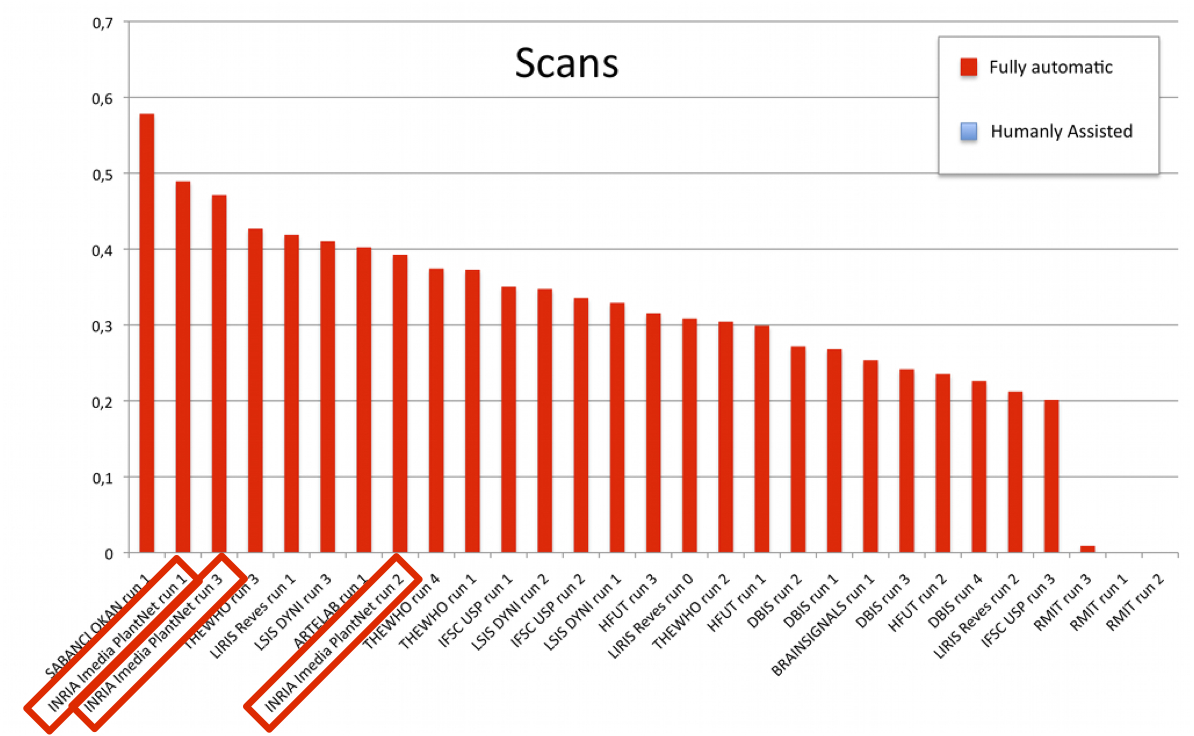Section: Dissemination
Scientific Animation
The ImageCLEF2012 Plant Task Identification Organisation and participation
Participants : Vera Bakic, Itheri Yahiaoui, Sofiene Mouine, Saloua Ouertani-Litayem, Wajih Ouertani, Anne Verroust-Blondet, Hervé Goëau.
We organized for the second year the plant task identification at the ImageCLEF evaluation forum for the cross–language annotation and retrieval of images (http://www.imageclef.org/2012/plant). The ImageCLEF's plant identification task [21] provides a testbed for the system-oriented evaluation of plant identification, more precisely on the 126 tree species identification based on leaf images. Three types of image content were considered: Scan, Scan-like (leaf photographs with a white uniform background), and Photograph (unconstrained leaf with natural background). The main originality of this data is that it was specifically built through a citizen sciences initiative conducted by Tela Botanica, a French social network of amateur and expert botanists. This makes the task closer to the conditions of a real-world application. With a total of eleven groups from eight countries and with a total of 30 runs submitted, involving distinct and original methods, this second year pilot task confirmed Image Retrieval community interest for biodiversity and botany, and highlights further challenging studies in plant identification.
For the second year, members of IMEDIA2 team participated within the Pl@ntNet project to the ImageCLEF plant identification task [20] . The runs submitted used very distinct approaches sometimes relying on similar extracted features. For Scan and Scan-like categories, the first two runs combined distinct local and contour approaches in two ways (late and early fusion), while the third run explored the learning capacity of a multi-class SVM technique on a contour based descriptor. For Photograph, our runs used local features positioned towards the center of the image to reduce the impact of background features. In the second run, an automatic segmentation with a rejection criterion was attempted. In the third run, points were associated with interesting zones. In general, even if they were distinct, the methods used performed very well.
Nozha Boujemaa
Re-elected member in the Steering Board of NEM ETP (Networked and Electronic Media European Technology Platform) and acting as Inria representative.
Founding member of the ACM ICMR "ACM International Conference on Multimedia Retrieval" born from the fusion of: ACM MIR (International Conference on Multimedia Information Retrieval) and ACM CIVR (International Conference on Image and Video Retrieval)
Responsibilities within Inria: Director of the Inria Saclay Ile-de-France research center.
Anne Verroust-Blondet
Member of the steering committee of Pl@ntNet (WP5 co-leader: “Dissemination”).
Member of the committee for the "Corpus, data and tools for research in Humanities and Social Sciences" 2012 programme of the Social Sciences and Humanities department of the French National Research Agency (ANR).
Member of the committee for the "COOPERATION 2011 - Partnerships of Production and Research Institutions in Focused Research and Technology Sectors" national action of the Ministry of Education, lifelong learning and religious affair of the Hellenic Republic.
Member of the steering committee of the CNRS GDR IG (Informatique Graphique).
Member of the technical programme committee of the Fourth International Conference on Advances in Multimedia (MMEDIA 2012).
Member of the editorial board of the “Revue Electronique Francophone d'Informatique Graphique” (REFIG).



